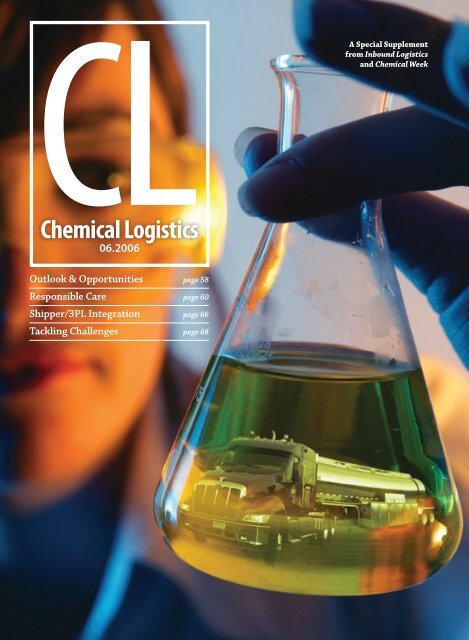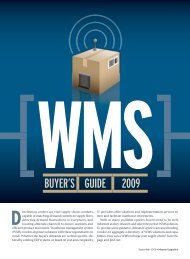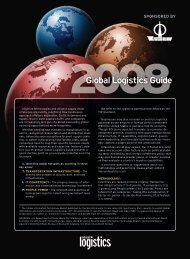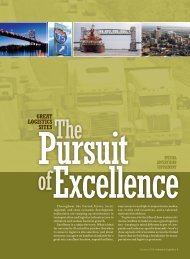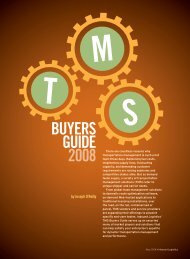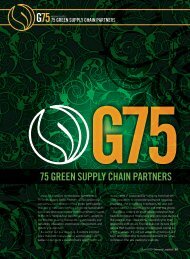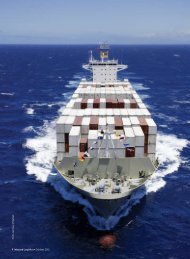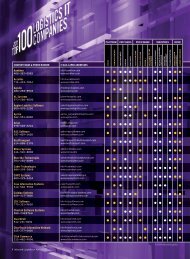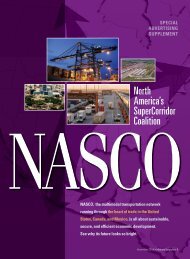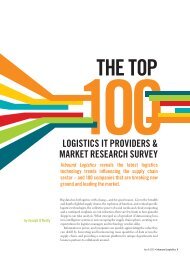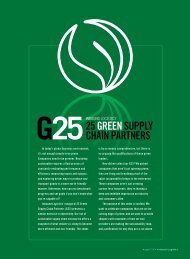Chemical Logistics - Inbound Logistics
Chemical Logistics - Inbound Logistics
Chemical Logistics - Inbound Logistics
Create successful ePaper yourself
Turn your PDF publications into a flip-book with our unique Google optimized e-Paper software.
CL<br />
<strong>Chemical</strong> <strong>Logistics</strong><br />
06.2006<br />
A Special Supplement<br />
from <strong>Inbound</strong> <strong>Logistics</strong><br />
and <strong>Chemical</strong> Week<br />
Outlook & Opportunities page 58<br />
Responsible Care page 60<br />
Shipper/3PL Integration page 66<br />
Tackling Challenges page 68
CL<br />
<strong>Chemical</strong> <strong>Logistics</strong><br />
A JOINT SUPPLEMENT FROM<br />
Outlook & Opportunities<br />
in <strong>Chemical</strong> <strong>Logistics</strong><br />
Keeping our ducks in a row comes naturally.<br />
Today: getting goods to<br />
and from the warehouse;<br />
tomorrow: where to<br />
put the warehouse?<br />
By Gregory DL Morris<br />
From the outside, the chemical<br />
logistics business looks<br />
like undiscovered country,<br />
ripe with opportunity for<br />
service providers. <strong>Chemical</strong> producers<br />
agree that those opportunities<br />
exist, but they are not the lowhanging<br />
fruit they appear to be.<br />
“A lot of service providers are<br />
trying to enter the chemical logistics<br />
market,” says Henry Ward,<br />
global director of transportation<br />
safety and security for Dow<br />
<strong>Chemical</strong>, based in Midland, Mich.<br />
“Generally, we negotiate our own<br />
contracts, and look to third-party<br />
logistics providers (3PLs) to execute.<br />
Increased visibility is the real<br />
need in the market, and service<br />
providers can help pull that data<br />
together. That is the direction we<br />
are headed.”<br />
The story is similar at another of<br />
North America’s largest producers.<br />
“Third-party logistics has certainly<br />
grown in the chemical industry,<br />
but with mixed results,” says Peter<br />
Masterman, vice president of logistics<br />
and customer service at Nova<br />
<strong>Chemical</strong>s in Calgary, Canada. “We<br />
look at distribution as a core competency<br />
– transit costs and service<br />
are critical to our business. Look<br />
at the margin on one pound of<br />
polymer, for example. We drive inventory<br />
pretty hard.”<br />
Nova does, however, use specialized<br />
outside logistics expertise<br />
in some cases. “We use 3PLs for<br />
freight forwarding, brokerage, and<br />
customs. We are particularly interested<br />
in 3PLs that can help in areas<br />
such as international shipments<br />
to places where we do not already<br />
have depth.”<br />
The pace of new entrants into<br />
the chemical 3PL market has<br />
slowed lately, says Kelly Elizardo,<br />
director of transportation and logistics<br />
assets at Philadelphia-based<br />
Sunoco. “We still get a steady<br />
drumbeat of 3PLs interested in<br />
our business, but it has declined a<br />
little since the initial rush,” she explains.<br />
“3PLs now understand that<br />
unlike other sectors, the chemical<br />
industry does a lot of best-practices<br />
sharing. <strong>Logistics</strong> is a core competency<br />
in this business, and there is<br />
a constant internal challenge in the<br />
industry to improve.”<br />
Sunoco has not used 3PLs to<br />
the extent other shippers have,<br />
Elizardo says. Mostly the opportunities<br />
for outsourcing have been in<br />
truck tendering and dispatching,<br />
and railcar tracking and tracing.<br />
“Shipment visibility is important,”<br />
she says. “We know where<br />
every car is inside the fence, and<br />
we understand that the national<br />
transportation infrastructure is a<br />
challenge for all carriers and service<br />
providers. That is why we want to<br />
be close partners with our vendors.<br />
Having safe, reliable, and environmentally<br />
sound operations inside<br />
and outside the plant is key.”<br />
Nova operates along the same<br />
lines. “‘Responsible Care’ is a longstanding<br />
ethic in this industry,”<br />
says Masterman. “Now that we<br />
are looking at the entire supply<br />
chain as a value chain, Responsible<br />
Care makes our thinking outside<br />
the fence line more holistic.<br />
Responsible Care provides a riskbased<br />
approach, and we use those<br />
selection criteria when we have the<br />
ability to choose a carrier, terminal,<br />
or other logistics provider.” (See<br />
next feature for more information on<br />
Responsible Care.)<br />
Masterman sees better service<br />
opportunities in areas such as<br />
tracking and tracing, invoice and<br />
payment service, and scheduling.<br />
“We occasionally bring contractors<br />
to our sites, but it is more<br />
common to have an onsite 3PL that<br />
physically operates packaging and<br />
shipping in Europe than in North<br />
America,” he says.<br />
Becoming an onsite 3PL for<br />
At LOGISCO, we’re in the business of keeping your ducks<br />
in a row. We don’t just protect your product and your<br />
bottom line, but your reputation as well.<br />
The LOGISCO solution provides the care your industry,<br />
products, and the public needs. We understand your<br />
unique business environment, it’s competitive costs and<br />
required service levels.<br />
LOGISCO provides:<br />
Outstanding contract and public warehousing services<br />
Dedicated distribution center management<br />
Core competency serving the chemicals industry<br />
Significant scope in locations and services<br />
Transportation management<br />
Advanced, stable technology<br />
Flexible and innovative solutions<br />
Get your ducks in a row. Call today or visit us<br />
online to learn more about our solutions.<br />
ENHANCING BUSINESS THROUGH LOGISTICS<br />
www.teamlogisco.com 1.800.526.3404<br />
58 <strong>Inbound</strong> <strong>Logistics</strong> • June 2006
chemical producers is the goal for<br />
supply chain solutions provider<br />
Exel, Columbus, Ohio.<br />
“Seventy-five to 80 percent of<br />
our chemical customers are Tier<br />
1 producers – the big household<br />
names,” says Gary Williams, president<br />
of the chemical and industrial<br />
sectors for Exel. “But we do not<br />
manage the whole supply chain –<br />
end to end – for any one company<br />
yet. We have the capacity to do so,<br />
but we have not yet been asked to<br />
provide that service. We are, however,<br />
in discussion with several<br />
customers to do it.”<br />
Until such time, there are plenty<br />
of incremental openings in chemical<br />
logistics, Williams says.<br />
“Opportunities exist if you understand<br />
what services to offer,” he<br />
notes. “Producers are cleaning up<br />
their portfolios. In some cases, we<br />
have taken over 100 percent of processing<br />
for a customer – that means<br />
grinding, additives, and packaging<br />
or bulk shipping. We may need to<br />
use dedicated lines for this service;<br />
other times we can spread the cost<br />
of assets over several customers.”<br />
For service providers, the essential<br />
fact to remember is that<br />
the chemicals industry is “a mature<br />
business with the same competencies,”<br />
says Mark Rourke, vice<br />
president and general manager<br />
of transportation management<br />
at Schneider <strong>Logistics</strong>, Green Bay,<br />
Wisc. “3PLs must consider the opportunities.<br />
Are we helping chemical<br />
companies think about the next five<br />
years rather than the next five days?<br />
We always think of end-to-end total<br />
costs, not just the dollar costs of<br />
transportation.”<br />
Some technology and techniques<br />
– such as vendor-managed<br />
inventory and RFID – popular in<br />
discrete-goods logistics are making<br />
their way into chemical logistics.<br />
“But companies have to think longterm,”<br />
says Rourke. “While you are<br />
concerned today with getting goods<br />
to or from the warehouse, you also<br />
have to be thinking about the best<br />
place to locate the warehouse.” CL<br />
<strong>Chemical</strong> Producers Put<br />
New Emphasis on <strong>Logistics</strong><br />
Safety and Security<br />
Responsible Care<br />
becomes the common<br />
ground for shippers<br />
and service providers.<br />
By Gregory DL Morris<br />
Enhancements to chemical<br />
producers’ self-imposed<br />
mandates for product<br />
safety and security in commerce<br />
are underway across North<br />
America. Both the American<br />
Chemistry Council (ACC) and the<br />
Canadian <strong>Chemical</strong> Producers’<br />
Association (CCPA) are broadening<br />
their transportation and distribution<br />
requirements under the<br />
Responsible Care codes of management<br />
practice.<br />
<strong>Chemical</strong> production responds<br />
well to economies of scale, so logistics<br />
is an essential part of the<br />
industry. In 2004, the latest year<br />
for which complete statistics are<br />
available, $516.2 billion of chemicals<br />
were produced in the United<br />
States, and cost $33.2 billion to<br />
transport from producers to users.<br />
<strong>Chemical</strong>s are also among<br />
the United States’ and Canada’s<br />
top three goods exports each year.<br />
Bilateral chemical trade is considerable,<br />
and the United States is also<br />
an important worldwide chemical<br />
exporter.<br />
“In 2002, chemical companies<br />
placed heavier emphasis on managing<br />
products outside the fence<br />
line,” says Debra Phillips, managing<br />
director of Responsible Care<br />
for Arlington, Va.-based ACC. Most<br />
importantly, the industry put in<br />
place a process for qualifying carriers,<br />
distributors, and other service<br />
providers on Responsible Care<br />
standards. The qualifications are<br />
scheduled to be completed between<br />
2005 and 2007.<br />
The Responsible Care codes of<br />
management for process safety,<br />
health, and environmental compliance<br />
were first developed by<br />
Ottawa-based CCPA in 1978. The<br />
ACC quickly adopted them, and<br />
both organizations have continued<br />
to expand and adapt the codes.<br />
ACC developed Transportation<br />
Community Awareness and<br />
Emergency Response (TransCAER)<br />
In rail we trust: <strong>Chemical</strong> producers spent $33.2 billion transporting chemicals<br />
in 2004, with many shipments – due to their hazardous nature – sent via rail.<br />
All North American Class I railroads are major chemical haulers.<br />
WEKNOWCHEMICAL<br />
Let’s face it. Your job is hard enough without having to explain the logistic demands in your supply chain.<br />
Every day changes. You need a 3PL provider that can hit the ground running with the knowledge, flexibility<br />
and service performance levels that will make your job easier. LeSaint <strong>Logistics</strong> is a nationally recognized<br />
3PL provider, specializing in the chemical industry. We’re committed to you. After all, knowledge is power<br />
and we know chemical. Call us today!<br />
• Contingency and site emergency plans<br />
• Federal, state and local reporting<br />
• H2, H3 and H4 storage<br />
• Primary and secondary containment systems<br />
• Centrally monitored security and ESFR sprinkler systems<br />
• Red label storage with AFFF in rack foam system<br />
• Hazmat certified drivers<br />
Warehouse Management | Fulfillment | Transportation<br />
60 <strong>Inbound</strong> <strong>Logistics</strong> • June 2006<br />
2570 Northwest Parkway Elgin, IL 60124 Phone: 847-783-4940 www.lesaint.com<br />
© 2006 LeSaint <strong>Logistics</strong>
in 1985, which was soon adopted<br />
by CCPA. The U.S. codes of management<br />
practice have an explicit<br />
product stewardship code, and<br />
CCPA developed specific product<br />
stewardship guidelines at the end<br />
of 2004.<br />
ACC encourages all chemicals<br />
service providers to become<br />
full-fledged Responsible Care partners,<br />
adopting the complete codes<br />
of practice. All Class I railroads in<br />
North America are major chemical<br />
haulers, and all are partners. More<br />
than two dozen tank-truck carriers<br />
are also partners.<br />
Carriers and logistics providers<br />
that are not Responsible Care partners<br />
are usually audited by a third<br />
party using criteria established by<br />
ACC. The evaluation alone does not<br />
qualify a provider as having proper<br />
practices; each shipper analyzes the<br />
results to decide on its own whether<br />
or not to use them. Some large<br />
shippers also conduct their own<br />
proprietary audits.<br />
“Safety, reliability, and environmentally<br />
sound operations are the<br />
Enhancements to<br />
chemical producers’<br />
self-imposed product<br />
safety and security<br />
mandates are underway<br />
across North America.<br />
tenets of our business inside and<br />
outside the fence line,” says Kelly<br />
Elizardo, director of transportation<br />
and logistics at Sunoco. “Those<br />
subjects are the first discussion we<br />
have with any carrier or 3PL, and it<br />
is an easy step if they are involved<br />
in Responsible Care.”<br />
Together with a global product<br />
strategy announced at an<br />
international meeting of national<br />
chemical industry associations<br />
in Dubai in February, the new<br />
Responsible Care codes “redefine<br />
the relationship producers have<br />
with distribution in all aspects of<br />
the value chain,” says Brian Wastle,<br />
vice president for Responsible<br />
Care at CCPA. “Up to now, product<br />
stewardship has been about risk<br />
management, not about risk reduction.<br />
Now the emphasis is on<br />
finding safer alternatives.”<br />
This is where distribution and<br />
logistics companies play an important<br />
role. Reducing the distances<br />
shipments travel, the amount of<br />
handling that occurs, and the number<br />
of people and steps involved<br />
in chemical logistics reduces both<br />
risks and costs, Wastle says.<br />
Top 10 Practices for Shipping <strong>Chemical</strong>s by Rail<br />
Whether you are a chemical shipper, carrier, or service provider, safety is<br />
crucial. Use these 10 tips to ensure safe rail shipping.<br />
1<br />
Develop and implement a<br />
securement policy that includes<br />
pre-loading inspections,<br />
post-loading inspections, and a<br />
corresponding safety checklist.<br />
n Pay special attention to ensure<br />
that railcars are not overloaded,<br />
especially for hazardous material<br />
shipments.<br />
2<br />
Inspect valves/domes for<br />
tightness – this is a leading<br />
cause of leaks/spills in rail<br />
transportation incidents.<br />
n After loading, leak-test the car<br />
by applying at least 10 psig of pressure<br />
over the maximum estimated<br />
transportation pressure. Check all<br />
valves, packing gland nuts, closures<br />
and flanges using a leak detection<br />
solution or ultrasonic instrument.<br />
After completing the leak test,<br />
release or reduce pressure.<br />
n If a pressure test is impractical<br />
or unsafe, the railcar in question<br />
should be held and reinspected after<br />
24 hours. Valves and fittings should<br />
be re-tightened as needed.<br />
3<br />
Review shipping papers<br />
to ensure adequate data.<br />
n Promote Electronic Data<br />
Interchange for all shipments.<br />
4<br />
Ensure that proper<br />
placarding is maintained<br />
for all railcars.<br />
n Utilize recto-reflective<br />
placards, a requirement for bulk<br />
consignments.<br />
n Shippers should eliminate<br />
using paper placards whenever<br />
possible.<br />
5<br />
Ensure that the<br />
Emergency Response<br />
Plan is correct and updated for<br />
plant sites and transportationrelated<br />
releases.<br />
n Conduct an annual drill of the<br />
Emergency Response Plan.<br />
n Shippers must show proper<br />
ERP number and associated telephone<br />
number on dangerous goods.<br />
n Ensure that emergency<br />
contacts and telephone numbers for<br />
the railroad and plant site are correct<br />
and updated regularly.<br />
6<br />
Implement these key<br />
training programs:<br />
n All railroad personnel entering<br />
the plant site should be properly<br />
trained and/or receive orientation,<br />
especially for emergency actions.<br />
n Establish, document, communicate,<br />
and implement a companywide<br />
tank car securement training<br />
program.<br />
n Establish, document, train, and<br />
implement a procedure for tank car<br />
customers to report poor securement,<br />
hard-to-operate valves, and other<br />
fitting problems.<br />
n Establish, document, train,<br />
and implement company-wide<br />
preventive maintenance practices<br />
for tank cars.<br />
7<br />
Ensure that all rail crossings<br />
within the plant site are<br />
properly marked with warning<br />
signs.<br />
8<br />
Check to be sure rail<br />
lines are clear, switches<br />
are aligned properly, and car<br />
brakes are released before<br />
moving cars.<br />
9<br />
Have plant personnel<br />
closely observe rail crews<br />
when they are operating<br />
within the plant site to assure<br />
plant and rail safety is<br />
maintained.<br />
10<br />
Have a documented<br />
routine process for providing<br />
feedback to rail carriers.<br />
SOURCE: UNION PACIFIC RAILROAD<br />
62 <strong>Inbound</strong> <strong>Logistics</strong> • June 2006
taking responsibility: Safety and security are crucial to the chemical industry. Many shippers require their carriers and 3PLs<br />
to adhere to the Responsible Care code of management practices for process safety, health, and environmental compliance.<br />
“Will a service provider automatically<br />
get more business from being<br />
a Responsible Care partner or from<br />
having comparable, verifiable practices?<br />
No. Will it make it a better<br />
company? Yes. And better companies<br />
get more business,” he says.<br />
Nevertheless, carrier acceptance<br />
is not universal. “We are a<br />
Responsible Care partner carrier<br />
because we view the codes as consistent<br />
with our core values,” says<br />
George Grossardt, vice president<br />
and general manger of bulk transport<br />
at Schneider National, Green<br />
Bay, Wisc. “And we plan to remain a<br />
partner. But for some carriers it is<br />
a business decision. In this capacity-constrained<br />
market, shipments<br />
will move regardless. It’s hard to<br />
criticize small operators who don’t<br />
participate in Responsible Care.”<br />
Producers and chemical associations<br />
have enhanced their service<br />
provider audit program, and some<br />
shippers have pledged to give most<br />
of their business to partner or<br />
complying carriers. Dow <strong>Chemical</strong>,<br />
for example, has said that by 2008,<br />
“every raw material supplier and every<br />
logistics service provider must<br />
be a Responsible Care company or<br />
partner, or have implemented an<br />
equivalent program as determined<br />
through audits,” says Henry Ward,<br />
Dow’s director of transportation<br />
safety and security.<br />
These requirements lessen his<br />
staff’s supervisory burden, and<br />
help service providers.<br />
“We have been focused on the<br />
Responsible Care security code,<br />
and on the partner program. We’ve<br />
put a lot of energy into that,” Ward<br />
says. “The bottom line is, we are<br />
interested in performance, and<br />
Responsible Care is performance<br />
in a recognizable and verifiable<br />
format.”<br />
The codes also provide a common<br />
ground for close relationships<br />
between shippers and carriers.<br />
Earlier this year, for example, Dow<br />
formed a safety and security partnership<br />
with its largest rail carrier,<br />
Union Pacific (UP). “We are focused<br />
on six key areas: supply chain redesign,<br />
next-generation tank cars,<br />
improving shipment visibility,<br />
strengthening the commitment to<br />
TransCAER, overall safety improvements,<br />
and hazardous-materials<br />
routing,” says Ward.<br />
“Some of these are Dow’s responsibility,<br />
some are UP’s and some<br />
are joint responsibilities. We know<br />
which is which, and we have specific<br />
performance objectives,” he adds.<br />
Other chemical companies plan<br />
to restrict their service providers to<br />
some degree. “Honeywell has committed<br />
to using only Responsible<br />
Care carriers for its bulk chemicals,<br />
and Rohm & Haas will forego<br />
its own company audits for partner<br />
carriers,” reports ACC’s Phillips.<br />
“We get a lot of inquiries on how<br />
to approach Responsible Care,” she<br />
adds. “To join Responsible Care, a<br />
prospective partner firm has to be<br />
sponsored by two ACC member<br />
companies. Some members have<br />
also sponsored prospective service<br />
providers.”<br />
CL<br />
64 <strong>Inbound</strong> <strong>Logistics</strong> • June 2006<br />
Resource Card # 395
True Shipper-<strong>Logistics</strong> Provider<br />
Integration Inches Closer to Reality<br />
Service providers are<br />
moving inside the fence<br />
line and working with<br />
shippers’ customers.<br />
by Gregory DL Morris<br />
After more than a decade of<br />
trying to become the shipping<br />
desk for chemical<br />
producers, logistics providers<br />
can point to many successes,<br />
but not quite the ubiquity they<br />
hoped for.<br />
And now new challenges are<br />
arising. Not even gasoline at $3-<br />
per-gallon can keep U.S. drivers<br />
off the highways. Congestion is<br />
also an issue for most of the North<br />
American rail network, although<br />
the regional meltdowns of previous<br />
years are now just bad memories.<br />
“Today’s rail network movement<br />
is pretty good,” says Peter<br />
Masterman, vice president of logistics<br />
and customer service at<br />
Nova <strong>Chemical</strong>s, based in Calgary,<br />
Canada.<br />
“We are able to run more cars<br />
across limited infrastructure. The<br />
problems we encounter are in the<br />
first mile and the last mile, especially<br />
getting a specific car to a specific<br />
customer,” he says. “We are addressing<br />
these problems by educating<br />
customers about how railroads<br />
work. It’s not glamorous, and it<br />
requires hard work, but it is in everyone’s<br />
best interest.”<br />
Unlocking Value<br />
Dan Bingeman, assistant vice<br />
president of supply chain logistics<br />
for the Canadian National Railway,<br />
Montreal, disagrees. His parent<br />
railroad does not have a congestion<br />
problem, he says, adding that<br />
thanks to a new routing protocol<br />
among roads in the West, cycle<br />
times have improved for chemical<br />
shippers’ tank cars and hoppers.<br />
For the past few years,<br />
Bingeman has been operating a<br />
stand-alone 3PL focused on unlocking<br />
value in the North American<br />
rail infrastructure for chemical producers<br />
and logistics managers.<br />
“We offer granular services,<br />
starting way back in the supply<br />
chain with chemical companies’<br />
suppliers, all the way through rail<br />
and truck transport procurement.<br />
We also handle in-plant logistics<br />
for some customers,” he says.<br />
Most recently, Bingeman<br />
worked with Spanish producer<br />
Interquisa, which began base-loading<br />
the North American market<br />
by shipping purified terephthalic<br />
acid, a precursor for PET resin,<br />
in advance of building a plant in<br />
Montreal.<br />
“We handled imports and logistics<br />
for Interquisa in North<br />
America,” says Bingeman. “We were<br />
also on site for the plant construction,<br />
consulting on logistics. As<br />
the plant became operational, we<br />
shifted from imports to domestic<br />
production.”<br />
Bingeman’s group now also handles<br />
logistics for one of Interquisa’s<br />
customers, PTT Poly Canada.<br />
“We have 47 active clients. Our<br />
role with those clients spans from<br />
one person acting as an on-site rail<br />
expert, to offering a full range of<br />
service as we do for Interquesa and<br />
PTT,” he explains.<br />
“The old rules of thumb on<br />
rail and truck transport are being<br />
turned on their heads,” he adds.<br />
“Once you start shining daylight on<br />
common practices, shippers find<br />
they not only improve performance<br />
and cut costs, but actually gain<br />
market share because they have<br />
more product available and can get<br />
it to the right markets.”<br />
Becoming Carrier-Friendly<br />
On the truck side, operators and<br />
3PLs alike will be cheered to hear<br />
Nova’s Masterman talk about utilization.<br />
“We are definitely trying to<br />
“The old rules of thumb on rail and truck transport<br />
are being turned on their heads. Once you shine<br />
daylight on common practices, shippers improve<br />
performance, cut costs, and gain market share<br />
because they have more product available.”<br />
– Dan Bingeman, Canadian National Railway<br />
be more carrier friendly. It used to<br />
be okay for a truck to sit and wait<br />
at our front gate for 20 minutes,<br />
then wait at the loading rack for 20<br />
minutes, then wait at the scale for<br />
20 minutes,” he says. “But that’s<br />
one hour lost. If we as shippers<br />
don’t respect carriers’ utilization,<br />
well, they have choices, too. It is<br />
the same situation at the ports.”<br />
Truck utilization has been<br />
thrown into stark relief by the<br />
growing driver shortage and restrictions<br />
on hours of service.<br />
“For 20 years we received reduced<br />
rates from carriers, but now<br />
we are on the other side,” says<br />
George Grossardt, vice president<br />
and general manger of bulk transport<br />
at Schneider National, based<br />
in Green Bay, Wisc. “We have to<br />
make hard decisions on driver<br />
demographics. We still use predominantly<br />
inexperienced drivers and<br />
train them.”<br />
Distributor Convergence<br />
The additional variable in the<br />
chemical logistics equation is the<br />
presence of distribution companies.<br />
Some, such as Ashland<br />
of Dublin, Ohio, are producers<br />
and distributors. Others, such as<br />
ChemCentral of Bedford Park, Ill.,<br />
are pure distributors.<br />
“There is some convergence between<br />
the services 3PLs perform and<br />
what we do,” says Mark Rost, director<br />
of purchasing, ChemCentral. His post<br />
was created this year to coordinate the<br />
company’s four regional purchasing<br />
managers.<br />
“Producers have made us look at<br />
every facility and examine whether<br />
we are operating at full capacity.<br />
Often we have found unused or underused<br />
assets,” Rost says. “We are<br />
also looking at facilities together<br />
with producers, answering questions<br />
such as, should we both have<br />
a tank of the same product within<br />
100 miles of each other?<br />
“Sometimes we are approached<br />
by suppliers, but we have also approached<br />
them,” he adds. “In some<br />
cases, we buy from them in drums.<br />
But we are good at drumming. This<br />
leads us to think, can we buy in<br />
bulk and drum for our customers?<br />
Maybe we can drum for their other<br />
customers, too?”<br />
Ashland also sees convergence<br />
between chemical 3PLs and<br />
distributors.<br />
“We consider ourselves a 3PL,”<br />
says Michael J. Shannon, executive<br />
vice president, global supply chain<br />
for Ashland, which is not only a<br />
You Don’t Have To<br />
Outsource…<br />
... Many Shippers Are Following<br />
New Roads To <strong>Logistics</strong> Savings.<br />
<br />
<br />
<br />
<br />
<br />
<br />
<br />
<br />
chemical producer, but also a large<br />
fleet operator, with 450 tractors<br />
and almost 1,000 trailers.<br />
“We use 3PLs in areas where<br />
we cannot add value, such as small<br />
quantity packaged goods,” says<br />
Shannon. “And some of our suppliers<br />
use us as a third-party logistics<br />
provider. Right now, producers and<br />
distributors are thinking about being<br />
in the right markets, and the number<br />
of operations in those markets.”<br />
The Final Test<br />
“The final test for 3PLs of any<br />
size is: what do they offer for<br />
shippers, and what do they offer<br />
for carriers?” says Schneider’s<br />
Grossardt. “Some 3PLs have been<br />
successful creating new models for<br />
other industry sectors.<br />
“But it will be more difficult in<br />
bulk chemicals,” he notes. “You<br />
can’t just run chemical products<br />
through crossdocks.”<br />
CL<br />
<br />
<br />
<br />
<br />
<br />
66 <strong>Inbound</strong> <strong>Logistics</strong> • June 2006 June 2006 • <strong>Inbound</strong> <strong>Logistics</strong> 67
In a volatile industry,<br />
chemical companies<br />
tackle multiple<br />
logistics challenges.<br />
by John Edwards<br />
For chemical company<br />
Hercules, logistics management<br />
has become a task<br />
worthy of its namesake. “The<br />
industry is changing so quickly,”<br />
says Bill Adams, Americas logistics<br />
director for Wilmington, Del.-based<br />
Hercules, a $2-billion company<br />
that produces an array of chemicals<br />
for paper, paint, and textile<br />
manufacturers.<br />
<strong>Chemical</strong> companies such as<br />
Hercules already bear high logistics<br />
costs due to the nature of<br />
their products, which are typically<br />
heavy, bulky, difficult to store,<br />
and hazardous. Now these firms<br />
face additional challenges, including<br />
skyrocketing energy prices, new<br />
Good<br />
Chemistry<br />
regulations, and a chronic shortage<br />
of suitable carriers.<br />
Interestingly, logistics costs<br />
have begun to outweigh manufacturing<br />
expenses for chemical<br />
companies, says Beth Enslow, a<br />
supply chain analyst with Bostonbased<br />
research firm Aberdeen<br />
Group. “<strong>Chemical</strong> companies realize<br />
logistics may be the next ‘spend<br />
bucket’ in their company, and they<br />
need to gain control to make sure<br />
they remain cost-competitive,” she<br />
explains.<br />
Good Times and Challenges<br />
Despite the many challenges,<br />
these are actually good times for<br />
the chemical industry. “U.S. chemical<br />
industry growth was relatively<br />
stagnant from 1997 to 2003, and<br />
it boomed in 2004,” says Balaji B.<br />
Capaloor, senior chemical industry<br />
research analyst at Frost &<br />
Sullivan, a business research firm<br />
located in San Antonio, Texas.<br />
Global chemical trading grew<br />
by 67 percent between 1999<br />
and 2004, reports Capaloor.<br />
Meanwhile, the industry has become<br />
more global, with the North<br />
American market increasingly relying<br />
on chemical imports, primarily<br />
from Asia.<br />
As their market expands and<br />
shifts focus, chemical companies<br />
face problems that are unique to<br />
their field. “The chemical industry<br />
is highly regulated, plus their transportation<br />
mix is different than<br />
most other industries. They have a<br />
higher percentage of rail and ocean<br />
shipments,” says Enslow.<br />
“We ship products via every<br />
freight mode – rail, barge, ocean<br />
container, bulk, air, pipeline, and<br />
truck,” says Tom Schick, senior distribution<br />
director of the American<br />
<strong>Chemical</strong> Council in Arlington, Va.<br />
The growing diversity of modes<br />
and destinations means new supply<br />
chain and security challenges<br />
for chemical companies. “As more<br />
of the industry’s customers move<br />
manufacturing abroad, chemical<br />
firms have to handle a greater<br />
number of cross-border shipments,<br />
and their inherent security issues,”<br />
says Enslow.<br />
Increased global sourcing is<br />
one reason Hercules joined the<br />
U.S. government’s Customs-Trade<br />
Partnership Against Terrorism<br />
(C-TPAT).<br />
C-TPAT, which began in 2002, is<br />
a voluntary government-business<br />
initiative that aims to strengthen<br />
supply chain and border security.<br />
Through the project, Customs and<br />
Border Protection asks importers,<br />
carriers, brokers, warehouse operators,<br />
and manufacturers to ensure<br />
the integrity of their security practices,<br />
and to communicate security<br />
guidelines to business partners<br />
within the supply chain.<br />
“We are impressed with the<br />
way the partnership works,” says<br />
Adams. “Faster import clearance at<br />
ports and borders is the immediate<br />
benefit of membership, but C-TPAT<br />
also gives importers a structured<br />
process to evaluate risks across the<br />
supply chain and to proactively upgrade<br />
standards.”<br />
Trucking On<br />
Hercules relies on motor freight<br />
carriers to get products to its customers.<br />
But access to carriers has<br />
been compromised in recent years<br />
by factors ranging from stricter<br />
government regulations to rising<br />
costs and even natural calamities.<br />
And Hercules, like its competitors,<br />
felt the impact of tighter U.S.<br />
Department of Transportation<br />
(DOT) Hours-of-Service rules in<br />
2004 that limited the amount of<br />
time drivers could spend on the<br />
road. <strong>Chemical</strong> firms and their<br />
trucking partners have long struggled<br />
to find skilled and certified<br />
drivers to haul their cargo, and the<br />
DOT’s new rules made a difficult<br />
situation more challenging.<br />
“The government’s action created<br />
an almost instant driver<br />
shortage, because shipping volumes<br />
were cresting at the same<br />
time,” explains Adams.<br />
Hercules reacted by working<br />
with its third-party logistics<br />
provider, Danbury, Conn.-based<br />
Odyssey <strong>Logistics</strong> & Technology, to<br />
widen its trucking carrier mix.<br />
Most shippers, including<br />
Hercules, have adjusted to carrier<br />
scheduling challenges through improved<br />
planning and lead times,<br />
and by rebalancing carrier-shipping<br />
lane matchups. But the situation<br />
continues to be somewhat fragile,<br />
notes Adams.<br />
“Truckload package freight is<br />
one mode where we still see lingering<br />
problems,” he says. “If you try<br />
New dynamics in the<br />
transportation market<br />
have forced chemical<br />
companies to reexamine<br />
their logistics<br />
infrastructure.<br />
For most, 3PLs are the<br />
wave of the future.<br />
to buy in the spot market to cover<br />
these loads, it is common to experience<br />
lower on-time pickup rates.”<br />
The tighter transportation<br />
market has resulted in new cost<br />
pressures and less flexibility among<br />
carriers to meet short-notice demand.<br />
“<strong>Chemical</strong> companies can<br />
still get competitive rates, preferred<br />
treatment, and good service,<br />
but the market is not as flexible as<br />
it used to be,” says Adams.<br />
Like many other U.S. chemical<br />
companies, Richmond, Va.-based<br />
Albemarle, which supplies specialty<br />
chemicals for water treatment, oilfield<br />
services, and high-tech parts<br />
cleaning, uses rail for long-distance<br />
shipments to ports and domestic<br />
customers.<br />
“Because of safety factors,<br />
we prefer shipping via rail,” says<br />
Barbara Little, the company’s vice<br />
president, government relations.<br />
“We transport chlorine and other<br />
chemicals; those shipments<br />
shouldn’t travel on the nation’s<br />
highways and byways.”<br />
Hitting the Rails<br />
Unfortunately, the chemical<br />
industry’s dependence on rail<br />
transportation, and the limited<br />
number of rail carriers in any particular<br />
geographic area, has led to<br />
a distorted rail market. The situation<br />
is exacerbated by the fact that<br />
chemical plants are often located in<br />
out-of-the-way places close to raw<br />
material sources.<br />
“Inherently, rail shippers end<br />
up being captive to one rail line,”<br />
says Little. “Nearly 60 percent of<br />
U.S. chemical companies are in that<br />
situation.”<br />
The railroads’ upper hand has<br />
led to a certain amount of customer<br />
frustration, according to<br />
Little. “We sent one shipment<br />
from our plant in South Carolina<br />
to Houston,” she recalls. “The direct<br />
route is through Louisiana, but<br />
this rail carrier wanted to take the<br />
shipment almost to the Canadian<br />
border and back again, just to keep<br />
it all on its line.” The carrier eventually<br />
relented.<br />
<strong>Chemical</strong> companies have little<br />
recourse but to bargain with the<br />
only rail carrier at their disposal.<br />
“If a trucking company gives you<br />
high rates or poor service, you can<br />
use another provider,” says Schick<br />
of The American <strong>Chemical</strong> Council,<br />
adding that plenty of choice also<br />
exists among barge lines and ocean<br />
and air cargo carriers. “But when<br />
one railroad is the only way in or<br />
out of your plant, you have no<br />
alternative.”<br />
Another financially important<br />
aspect of rail transport is that<br />
chemical companies must provide<br />
and maintain nearly 100 percent<br />
of the rolling stock they use. “The<br />
cost of buying or leasing cars falls<br />
squarely on the shipper,” explains<br />
68 <strong>Inbound</strong> <strong>Logistics</strong> • June 2006 June 2006 • <strong>Inbound</strong> <strong>Logistics</strong> 69
Schick. “The railroad does not supply<br />
rail cars, only the locomotive to<br />
power them.”<br />
As a result, most chemical companies<br />
must manage large numbers<br />
of rail cars, including tank cars and<br />
covered hopper cars, which are<br />
used to move dry chemicals. “That<br />
constitutes another cost element,<br />
in addition to freight rates and fuel<br />
surcharges,” Schick says.<br />
A Double-Shot of Pain<br />
As if trucking and rail headaches<br />
aren’t bad enough, chemical companies<br />
are also dealing with soaring<br />
energy costs. While rising oil and<br />
natural gas prices increase fuel surcharges<br />
for all shippers,<br />
the upward energy<br />
spiral presents a double<br />
shock to chemical<br />
manufacturers. That’s<br />
because chemical companies<br />
must pay for<br />
petroleum as a key ingredient<br />
in a wide<br />
range of products, as<br />
well as for use in the<br />
vehicles that transport<br />
their raw and finished<br />
materials.<br />
“Any manufacturer<br />
that relies on petrochemicals or<br />
petrochemical derivatives is feeling<br />
cost pressure,” says Adams.<br />
Frost & Sullivan’s Capaloor concurs.<br />
“High crude oil and natural<br />
gas prices have increased raw material<br />
costs,” he says. “They reached<br />
an all-time peak in 2005.”<br />
<strong>Chemical</strong> companies have little<br />
control over natural gas and energy<br />
pricing, however. Worse yet,<br />
sudden price hikes can quickly<br />
demolish carefully planned production<br />
and transportation budgets,<br />
while encouraging consumers to<br />
conserve their use of chemical<br />
products.<br />
“Natural gas, other petroleum<br />
products, and the cost and availability<br />
of energy are crucial issues<br />
to the chemical industry in the<br />
United States,” explains Schick.<br />
“They put pressure on our industry’s<br />
competitiveness.”<br />
Adams knows that pressure all<br />
too well. “Like most chemical firms,<br />
our raw material expenditures were<br />
up significantly last year, due to<br />
the cost pressure on petrochemical-based<br />
raw materials,” he says.<br />
“We have to pass these along in our<br />
pricing, while at the same time pursue<br />
alternate, more cost-effective<br />
raw material sources.<br />
“We are aggressively developing<br />
new and less costly sources in<br />
Eastern Europe and Asia,” he adds.<br />
But to take advantage of these<br />
more distant sources, a company’s<br />
global logistics processes must be<br />
robust and efficient. “Companies<br />
mixing it up: <strong>Chemical</strong> companies<br />
such as Hercules use a variety of<br />
modes to safely transport hazmat<br />
shipments and maintain cost<br />
efficiency amid rising expenses.<br />
with a manual, clumsy process for<br />
managing global transportation<br />
and inventories can easily wash out<br />
the benefits of cheaper material<br />
sources,” says Adams.<br />
New dynamics in the transportation<br />
market are forcing chemical<br />
companies to reexamine – and<br />
sometimes radically alter – their<br />
logistics infrastructure. Prior to<br />
2003, for example, Hercules operated<br />
its own transportation<br />
group, which managed the company’s<br />
freight operations and dealt<br />
directly with carriers and other<br />
transportation service providers.<br />
“But we realized we didn’t have<br />
the leverage or the technology to<br />
achieve the best overall transportation<br />
cost and service values, let<br />
alone respond to changes with the<br />
agility needed to be competitive,”<br />
says Adams.<br />
That’s when Hercules decided<br />
to work with 3PLs. The company<br />
turned to Odyssey <strong>Logistics</strong><br />
& Technology to handle its<br />
North American logistics operations,<br />
and de Rijke <strong>Logistics</strong> in<br />
the Netherlands to manage its<br />
European shipments.<br />
By partnering with a 3PL,<br />
Hercules is part of a growing chemical<br />
industry trend. These days,<br />
most small- to mid-sized chemical<br />
companies use some form of outside<br />
logistics help. For<br />
most chemical producers,<br />
3PLs are the wave<br />
of the future, says<br />
Adams.<br />
“Major chemical<br />
manufacturers may<br />
have the critical mass<br />
to justify in-house<br />
transportation, but for<br />
a company our size,<br />
using a 3PL makes a<br />
lot of sense,” he says.<br />
“Most importantly, it<br />
frees up resources we’d<br />
prefer to use to enhance the value of<br />
our chemical products and services.”<br />
Technology Solutions<br />
All chemical companies, whether<br />
or not they outsource logistics,<br />
are streamlining operations.<br />
“Companies are synchronizing<br />
their transportation assets,” says<br />
Enslow. “Rather than building a big<br />
warehouse, they are going directly<br />
from the production line to the rail<br />
car or tanker truck, skipping the intermediate<br />
storage area.”<br />
To better coordinate loading,<br />
unloading, and other operations,<br />
companies are turning to transportation<br />
management systems (TMS)<br />
to optimize their transportation<br />
networks. TMS products automate<br />
key elements of a company’s<br />
shipping infrastructure, including<br />
strategic and operational planning,<br />
network design, transportation execution<br />
and monitoring, invoicing,<br />
billing, and settlement.<br />
A variety of TMS software vendors,<br />
including i2 Technologies,<br />
Manugistics/JDA, and Oracle, serve<br />
the chemical industry. Atlantabased<br />
RMI offers a rail shipment<br />
tracking system for chemical<br />
shippers. The tool traces railcars<br />
contained in permanently assigned<br />
fleets, or rail shipments loaded in<br />
“free-running” equipment. It monitors<br />
both inbound and outbound<br />
rail shipments using car movement<br />
information from Class I railroads,<br />
and from more than 300 shortline<br />
and regional railroads.<br />
SAP targets the industry with<br />
a TMS product specifically geared<br />
toward chemical producers: SAP<br />
for <strong>Chemical</strong>s. The software is<br />
part of the vendor’s mySAP customer<br />
relationship management<br />
suite. “We offer compliance documentation,<br />
demand planning, and<br />
supply network planning capabilities<br />
for chemical companies,” says<br />
Marty Etzel, director of chemical<br />
solutions marketing for Walldorf,<br />
Germany-based SAP.<br />
<strong>Chemical</strong> companies also use<br />
technologies such as RFID and satellite-driven<br />
global positioning<br />
systems to maximize shipping efficiency<br />
and cut costs.<br />
<strong>Logistics</strong>-oriented technologies<br />
help companies in two ways,<br />
says Enslow. “These technologies<br />
give companies real-time goods visibility,<br />
which helps them improve<br />
supply chain management and address<br />
government regulations and<br />
security concerns,” she notes.<br />
The other key benefit is improved<br />
asset management. “If a<br />
company knows where its goods<br />
are, or when a tanker car enters<br />
its customer’s yard, for example, it<br />
can automatically be alerted before<br />
it has to pay detention charges,”<br />
Enslow says.<br />
Like all businesses, chemical<br />
companies’ main goal is to earn<br />
profits by selling products and services<br />
its customers need. Yet, due<br />
to their business’ inherently hazardous<br />
nature, thinking about<br />
safety and security comes naturally<br />
to chemical logistics managers.<br />
Hercules, for example, conducts<br />
random audits of carrier unloading<br />
activity to be sure carriers are<br />
performing these tasks safely, says<br />
Adams. It can be tempting for<br />
chemical companies to turn a blind<br />
eye toward carriers that sacrifice<br />
safety and security for the ability to<br />
offer lower bids, but Adams and his<br />
counterparts resist the urge to use<br />
carriers that cut corners.<br />
“It is incumbent on chemical<br />
shippers to be careful when selecting<br />
carriers. We must exercise due<br />
diligence to pre-qualify carriers<br />
that meet standards and will hold<br />
to those standards themselves,” he<br />
says. <br />
CL<br />
Importing...Improved.<br />
Logistically speaking, importers are vulnerable to unpredictable lead times between order and delivery<br />
from a foreign vendor. Non-importers can settle for an average cost of goods, but importer’s costs<br />
can be extremely volatile and need to be tracked at the shipment level each and every time. Customs<br />
delays...demurrage costs...duty...any number of additional factors...they all affect profits.<br />
Importers can now have a level of visibility over their business that was impossible just a few years<br />
ago. Access to this information has a profound effect on profitability.<br />
SALES &<br />
PURCHASES<br />
LOGISTICS<br />
INVENTORY<br />
FINANCES<br />
A unique solution to unique challenges<br />
Venture Information System (VIS) ERP Solution for Importers is<br />
the industry-specifi c solution that can make the difference between profi t<br />
and loss. Designed to provide a comprehensive view of the fi nancial and<br />
logistical information that is the lifeblood of your importing business, and<br />
tailored to the distinctive needs of importers, the key functions of VIS are:<br />
Costing via sophisticated fi nancial analysis tools<br />
Easy-to-understand supply chain visibility<br />
Customs compliance through document generation and management<br />
Live web demonstrations available. Visit ventureinformationsystem.com<br />
70 <strong>Inbound</strong> <strong>Logistics</strong> • June 2006<br />
106 Enterprise Drive • Kingston, NY 12401 • 845-383-3800<br />
www.ventureinformationsystem.com • tpeck@ventureinformationsystem.com


